Embarking on a journey to Tibet is an unforgettable experience. Planning a trip requires understanding the region’s unique travel regulations and high-altitude environment. TRAVELS.EDU.VN provides expert guidance and comprehensive services to ensure a seamless and enriching adventure to the roof of the world. Discover essential tips for your upcoming journey, including permit requirements and suggested itineraries for an incredible experience.
1. Who Can Travel Tibet? Understanding Eligibility and Age Limits
Tibet welcomes visitors of all ages who are physically capable of adapting to the high-altitude environment. While there is no formal age restriction, it is essential to consider the health and well-being of all travelers, especially young children and seniors.
- Infants and Young Children: Parents should consult with a pediatrician before bringing infants or young children to Tibet.
- Seniors: Older adults should undergo a thorough medical check-up to ensure they are fit for high-altitude travel.
It is essential to note that independent travel in Tibet is not permitted. All visitors must book their Tibet tour through a registered local travel agency, either as part of a group or on a private tour, accompanied by a licensed guide and driver.
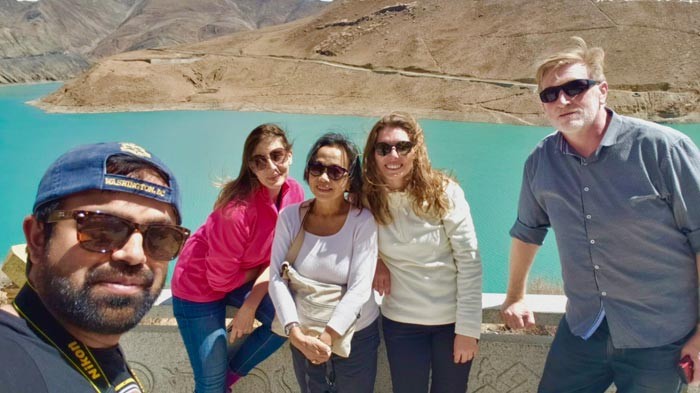 A family enjoying the scenery during a Tibet tour, showcasing intergenerational travel.
A family enjoying the scenery during a Tibet tour, showcasing intergenerational travel.
2. Staying Safe in Tibet: Essential Considerations for Travelers
Tibet is generally a safe destination for travelers, including solo travelers, women, and families. The region has good social security, and the local Tibetan people are known for their hospitality. However, altitude sickness is a significant concern that travelers should be aware of.
Altitude Sickness
Altitude sickness can affect anyone, regardless of age or physical fitness. It is caused by the reduced availability of oxygen at high altitudes. Symptoms can range from mild headaches and nausea to more severe conditions like pulmonary or cerebral edema.
Preventative Measures:
- Consult your doctor before traveling to Tibet to discuss altitude sickness and potential medications.
- Ascend gradually to allow your body to acclimatize to the altitude.
- Drink plenty of fluids and avoid alcohol and smoking.
- Rest upon arrival in Lhasa to allow your body to adjust.
- Consider taking medication like Acetazolamide (Diamox) to help prevent altitude sickness.
Health Conditions
Individuals with pre-existing health conditions, such as high blood pressure, cardiovascular disease, respiratory disease, coronary heart disease, severe asthma, or lung disease, should consult their doctor before traveling to Tibet. It is generally not recommended for individuals with these conditions to travel to high altitudes.
If you experience any discomfort while traveling in Tibet, contact your guide immediately.
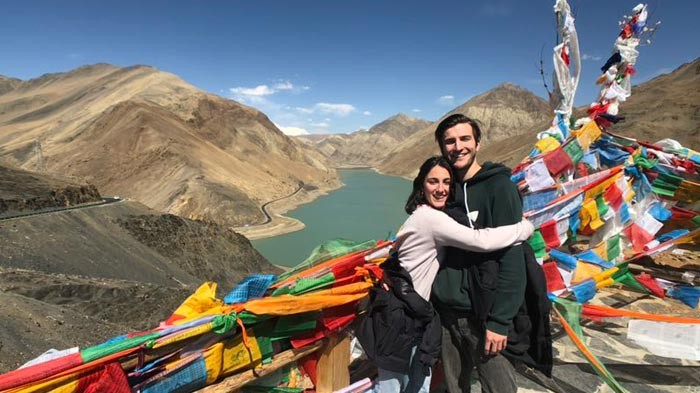 A couple admires a stunning Tibetan lake view, highlighting the serene and safe environment.
A couple admires a stunning Tibetan lake view, highlighting the serene and safe environment.
3. Essential Travel Documents: Tibet Travel Permit and Chinese Visa
To visit Tibet, travelers must obtain a Tibet Travel Permit, a Chinese Visa, and a valid passport. Without these documents, you will not be allowed to board a flight or train to Tibet.
Chinese Visa
You can obtain a Chinese Visa from the Chinese embassy or consulate in your country. The application process typically requires a valid passport, application form, passport photo, and supporting documents such as an itinerary and hotel booking.
Tibet Travel Permit
The Tibet Travel Permit can only be applied through a licensed local travel agency like TRAVELS.EDU.VN. To apply for the permit, you will need to provide a copy of your passport and Chinese Visa, as well as your travel itinerary. TRAVELS.EDU.VN will handle the application process on your behalf and ensure you have the necessary documents for your trip.
Important Considerations:
- Apply for your Tibet permit at least 20 days before your tour starts.
- Use the same passport for your Tibet Travel Permit application and your trip to Tibet.
- If entering Tibet from Nepal, you will need to apply for a Chinese group visa in Kathmandu.
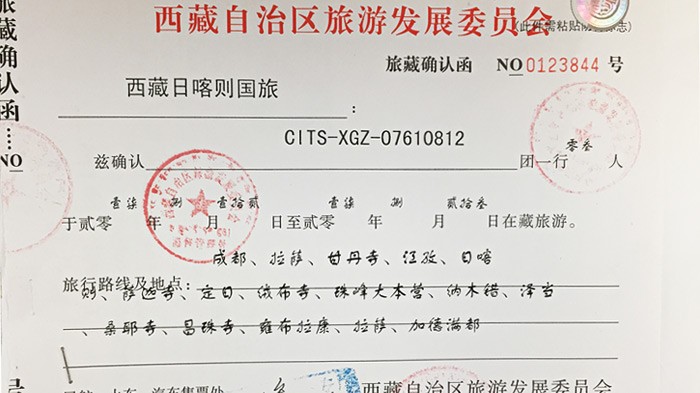 An example of a Tibet Travel Permit, essential for entering the region.
An example of a Tibet Travel Permit, essential for entering the region.
4. Budgeting Your Trip: How Much Does It Cost To Travel Tibet?
The cost of a Tibet tour can vary widely, ranging from $500 to over $2,500 (excluding transportation to Tibet). The total cost depends on the length of your stay, the travel season, the destinations you visit, the standard of accommodation you choose, and your personal expenses.
Here is a breakdown of potential expenses:
| Expense | Average Cost | Notes |
|---|---|---|
| Tibet Travel Permit | Included in tour | Usually handled by the travel agency |
| Chinese Visa | $140 – $160 | Varies by nationality |
| Flights to Tibet | $300 – $800 | Depends on origin city and season |
| Accommodation | $50 – $200/night | Varies by hotel star rating |
| Meals | $20 – $50/day | Depends on restaurant choice |
| Transportation within Tibet | Included in tour | Covers guide and driver services |
| Entrance Fees | $100 – $300 | Covers entrance fees to major attractions |
| Personal Expenses | Variable | Souvenirs, snacks, and optional activities |
| Total (Excluding Flights) | $690 – $2810+ | Wide range depending on your travel style and duration of visit |
Cost-Saving Strategies:
- Join a Tibet Small Group Tour: Sharing transportation, accommodation, and service fees with other travelers can significantly reduce costs.
- Travel in the Off-Season: Prices for flights and hotels are typically lower during the winter months (November to mid-February).
- Customize Your Group Tour: Gather a group of family and friends to create a custom tour, which can often result in discounted rates.
5. Timing Your Visit: When is the Best Time to Travel Tibet?
Spring and summer (April to June and September to October) are considered the best seasons to visit Tibet, offering pleasant weather with warm temperatures and clear skies. These months provide optimal conditions for enjoying the stunning mountain views, especially at Everest Base Camp.
Seasonal Highlights:
- Spring (April to June): Mild temperatures, blooming landscapes, and clear skies make this an ideal time for sightseeing and trekking.
- Summer (July to August): The rainy season brings lush greenery to the region, although rainfall is typically limited to nighttime. This is also peak season due to school holidays.
- Autumn (September to October): Similar to spring, autumn offers clear skies and comfortable temperatures, making it another excellent time to visit.
- Winter (November to March): While colder, winter offers a unique experience with fewer tourists and lower prices. Lhasa enjoys sunny days, and the winter landscape has its own charm.
Tibetan Festivals
Summer is also the season for several important Tibetan festivals, including the Shoton Festival, Saga Dawa Festival, and various horse racing festivals. These festivals offer a unique opportunity to immerse yourself in Tibetan culture and traditions. Check the updated Tibetan calendar for exact dates.
Festival Highlights:
| Festival | Month | Description |
|---|---|---|
| Shoton Festival | August | Celebrates the end of the monks’ summer retreat with opera performances and the unveiling of giant thangkas. |
| Saga Dawa Festival | May/June | Commemorates the birth, enlightenment, and death of Buddha with prayers and rituals. |
| Losar | February/March | Tibetan New Year, marked by family gatherings, feasts, and religious ceremonies. |
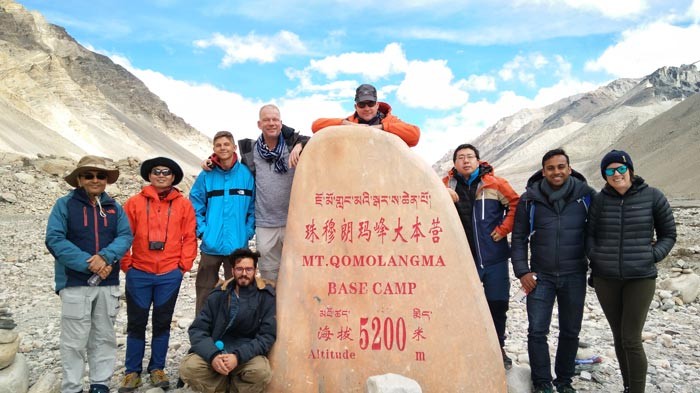 Panoramic view of Everest Base Camp in September, a favored time for clear weather.
Panoramic view of Everest Base Camp in September, a favored time for clear weather.
6. Getting to Tibet: Flights, Trains, and Overland Routes
Tibet is accessible by air, train, and overland routes, each offering a unique travel experience.
Flights to Tibet
Flying is the quickest and most convenient way to reach Tibet. Lhasa’s Gonggar Airport (LXA) is connected to major cities in mainland China, including Chengdu, Beijing, Shanghai, and Chongqing. Chengdu offers the most frequent daily flights to Lhasa and Nyingchi.
Trains to Tibet
The Qinghai-Tibet Railway is the world’s highest railway, offering a scenic journey across the Tibetan Plateau. Trains depart from several major Chinese cities, including Beijing, Shanghai, Guangzhou, Chengdu, Chongqing, and Lanzhou, all connecting to the Qinghai-Tibet railway in Xining.
Overland Routes to Tibet
Four highways connect Tibet to mainland China:
- Sichuan-Tibet Highway (G318 and G317)
- Qinghai-Tibet Highway (G109)
- Yunnan-Tibet Highway (G214)
- Xinjiang-Tibet Highway (G219)
These overland routes offer adventurous travelers the opportunity to experience the diverse landscapes and cultures of the Tibetan Plateau.
From Nepal
Kathmandu, Nepal, is the only international city with direct flights to Lhasa. Himalayan Airlines operates scheduled flights between Kathmandu and Lhasa. Alternatively, you can enter Tibet from Nepal by land via the Gyirong border, embarking on an epic overland journey from Kathmandu to Lhasa.
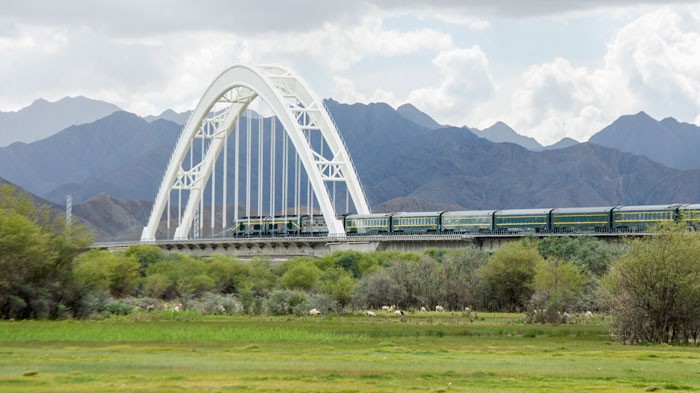 The Qinghai-Tibet Railway winds through the Tibetan landscape, showcasing the unique train journey.
The Qinghai-Tibet Railway winds through the Tibetan landscape, showcasing the unique train journey.
7. Getting Around Tibet: Transportation Options
Road travel is the primary mode of transportation within Tibet. If your tour includes attractions outside of Lhasa, be prepared for long-distance travel.
Road Conditions
Road conditions in Tibet have improved significantly in recent years. Most roads are now paved with asphalt, making them suitable for vehicles, bikes, and motorcycles.
Self-Driving Tours
Consider a self-driving tour to explore Tibet at your own pace. TRAVELS.EDU.VN can assist with arranging permits and vehicles for self-driving tours.
8. Must-See Places in Tibet: Lhasa, Everest Base Camp, and Mount Kailash
Tibet offers a wealth of cultural, spiritual, and natural attractions. Here are some of the must-see destinations:
Lhasa
Lhasa, the capital of Tibet, is a must-see destination for all visitors. A classic 4-day Lhasa tour includes visits to the Potala Palace, Jokhang Temple, and Sera Monastery.
Everest Base Camp
Everest Base Camp is a popular destination for travelers seeking to witness the world’s highest peak. An 8-day tour from Lhasa to Everest Base Camp includes an overnight stay at the base camp to enjoy the sunset or sunrise over Mount Everest.
Mount Kailash
Mount Kailash is a sacred peak revered by Buddhists, Hindus, Jains, and Bonpos. A Mount Kailash tour combines a classic Lhasa to EBC tour with an extended 3-day Kailash Kora (circumambulation) and a visit to Lake Manasarovar.
Lhasa to Kathmandu Overland Tour
The Lhasa to Kathmandu tour covers the best attractions along the Sino-Nepal Friendship Highway, offering a scenic overland journey through the Himalayas.
9. Packing Essentials: What to Bring on Your Tibet Tour
Packing appropriately is essential for a comfortable and safe trip to Tibet. Here are some essential items to include in your packing list:
Clothing
Warm clothing is crucial, as temperatures can fluctuate dramatically, especially at high altitudes. Pack layers to adjust to changing conditions. A windproof jacket is highly recommended.
Footwear
Comfortable shoes are essential for walking and exploring. If you plan on trekking, bring hiking boots.
Skincare
The high altitude and dry climate can take a toll on your skin. Pack lotion and lip balm to stay moisturized.
Sun Protection
Protect yourself from the intense sun with sunscreen (SPF 50 or higher), a hat, and sunglasses.
Medications
Bring any necessary prescription medications, as well as over-the-counter remedies for colds, gastrointestinal issues, and pain relief. Consult your doctor about medications for altitude sickness.
Other Essentials
- Travel Documents: Passport, Chinese Visa, Tibet Travel Permit
- Camera: To capture the stunning landscapes and cultural sites
- Power Adapter: Tibet uses Type A and D outlets, so bring an adapter if needed.
- Snacks: For long journeys and high-altitude hikes
- Water Bottle: Stay hydrated at all times
 Travelers pack for a trek in Tibet, highlighting essential gear and clothing.
Travelers pack for a trek in Tibet, highlighting essential gear and clothing.
10. Accommodation and Dining Tips: What to Expect in Tibet
Accommodation
Hotel standards in Tibet are generally lower than those in major cities in China. The best hotels are located in Lhasa, Shigatse, and Nyingchi. In more remote areas, such as Everest Base Camp and Mount Kailash, expect to stay in guesthouses or yak tents with basic facilities.
Dining
Tibetan cuisine includes dishes such as tsampa (roasted barley flour), yak butter tea, Tibetan noodles, and yak meat. Chinese dishes are also widely available. In Lhasa, you can find a wider variety of cuisines, including Nepali, Indian, and Western options.
If you have special dietary requirements, inform your travel consultant or tour guide in advance so they can make appropriate arrangements.
Conclusion
Traveling to Tibet offers an unparalleled opportunity to experience the unique culture, stunning landscapes, and spiritual atmosphere of the Tibetan Plateau. With careful planning and the assistance of a reputable travel agency like TRAVELS.EDU.VN, your journey to Tibet will be an unforgettable adventure.
Ready to Embark on Your Tibet Adventure?
Contact TRAVELS.EDU.VN today to start planning your dream trip to Tibet. Our expert travel consultants can help you with all aspects of your tour, including permits, visas, transportation, accommodation, and customized itineraries.
TRAVELS.EDU.VN
- Address: 123 Main St, Napa, CA 94559, United States
- WhatsApp: +1 (707) 257-5400
- Website: TRAVELS.EDU.VN
Let us help you create memories that will last a lifetime.
Frequently Asked Questions (FAQ)
1. Is it safe to travel to Tibet?
Yes, Tibet is generally safe for travelers. However, altitude sickness can be a concern, so it is important to take precautions.
2. What documents do I need to travel to Tibet?
You need a valid passport, a Chinese Visa, and a Tibet Travel Permit.
3. How do I get a Tibet Travel Permit?
The Tibet Travel Permit can only be applied through a licensed local travel agency like TRAVELS.EDU.VN.
4. What is the best time to visit Tibet?
Spring and autumn (April to June and September to October) offer the best weather for traveling in Tibet.
5. How much does it cost to travel to Tibet?
The cost varies depending on the length of your stay, the destinations you visit, and your choice of accommodation. A typical tour can range from $500 to over $2,500 (excluding transportation to Tibet).
6. What should I pack for a trip to Tibet?
Pack warm clothing, comfortable shoes, sunscreen, a hat, sunglasses, and any necessary medications.
7. What is the food like in Tibet?
Tibetan cuisine includes dishes such as tsampa, yak butter tea, Tibetan noodles, and yak meat. Chinese dishes are also widely available.
8. What are some must-see places in Tibet?
Some must-see places include Lhasa, Everest Base Camp, and Mount Kailash.
9. Can I travel to Tibet independently?
No, independent travel in Tibet is not permitted. You must book your tour through a registered local travel agency.
10. How can TRAVELS.EDU.VN help me plan my trip to Tibet?
travels.edu.vn can assist with all aspects of your Tibet tour, including permits, visas, transportation, accommodation, and customized itineraries.